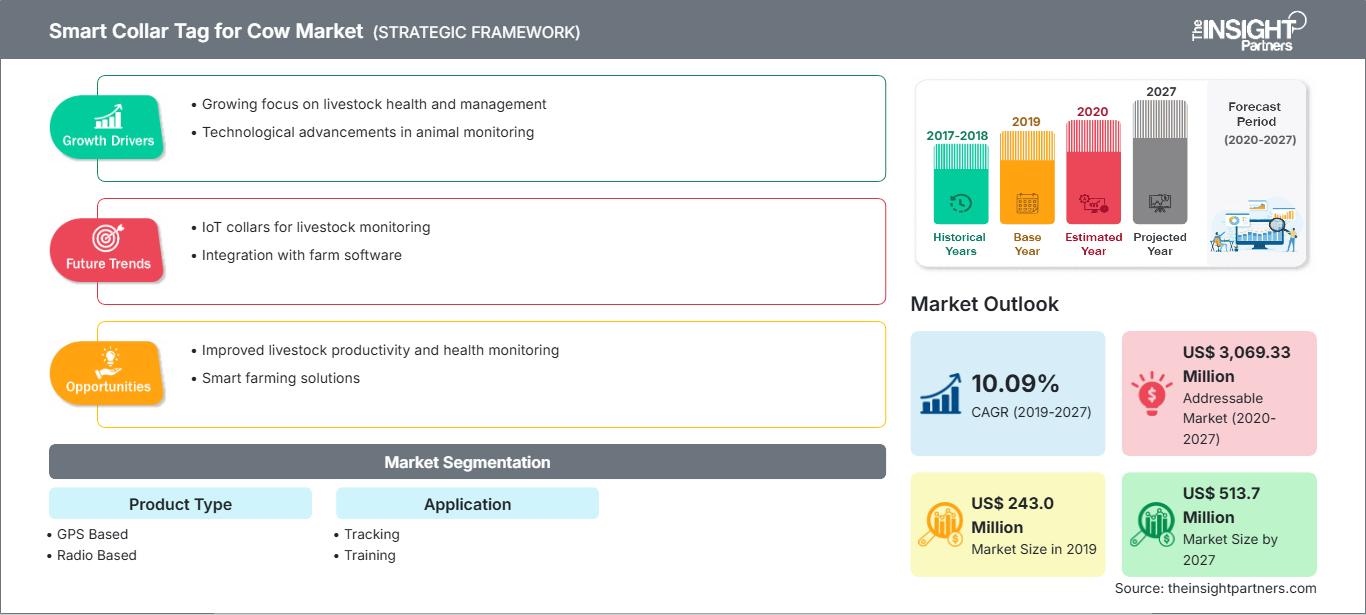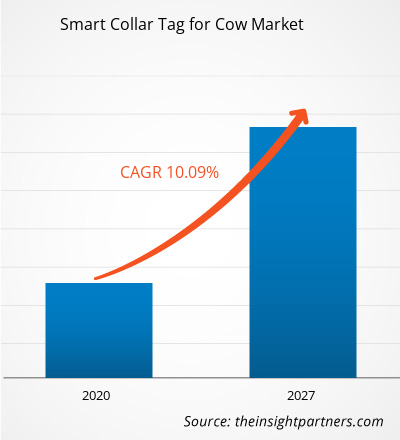Der Markt für intelligente Halsbandmarken für Kühe hatte 2019 einen Wert von 243,0 Millionen US-Dollar und soll bis 2027 513,7 Millionen US-Dollar erreichen; für den Zeitraum 2020–2027 wird ein CAGR-Wachstum von 10,09 % erwartet.
Die Land- und Viehwirtschaft setzt zunehmend auf Automatisierung, um den Zeitaufwand für landwirtschaftliche Tätigkeiten zu reduzieren. Präzise landwirtschaftliche Verfahren helfen Landwirten, ihre Gewinnspanne zu erhöhen und den Personalaufwand zu senken. Vieh- und Milchwirtschaft florieren mit steigender Nachfrage nach Milchprodukten. Das weltweite Bevölkerungswachstum ist ein Schlüsselfaktor für das Wachstum der Milchwirtschaft. Technologische Fortschritte in der Milchwirtschaft – wie kostengünstige Automatisierung, moderne Melkroboter, Ohrmarken und Halsbandmarken zur Überwachung der Viehaktivität – bieten Landwirten verbesserte Vorteile und tragen so zum Marktwachstum bei. Das steigende Bewusstsein der Landwirte und die veränderte Einstellung gegenüber Hochtechnologie sind Schlüsselfaktoren für das Marktwachstum. Die zunehmende Verwendung intelligenter Halsbänder zur Ortung von Kühen sowie zur Überwachung ihres Verhaltens und Gesundheitszustands steigert die Nachfrage nach diesen Geräten bei Milchbauern und Viehzüchtern. Fortschrittliche Entwicklungen bei intelligenten Halsbändern, wie z. B. eine längere Batterielaufzeit, die Unterstützung von Solarstrom und die Integration fortschrittlicher Sensoren, steigern ihre Leistung weiter. Intelligente Halsbänder werden eingesetzt, um das Problem von Viehdiebstahl und -diebstahl in afrikanischen Ländern zu lösen. Darüber hinaus erfassen intelligente Halsbänder für Kühe enorme Datenmengen, die den Landwirten durch die Überwachung des Verhaltens einzelner Kühe helfen, ihre Produktivität zu steigern.
Die intelligenten Halsbänder sind mit Servern verbunden und liefern Informationen auf den Smartphones, Tablets und PCs der Milchbauern. Der einfache Zugriff auf den Standort der Kuh und die Echtzeitüberwachung fördern die Verwendung intelligenter Halsbänder bei Milchbauern und Viehzüchtern. Die COVID-19-Pandemie hat die Bedeutung der Agrar- und Viehwirtschaft weiter gestärkt. Die Nachfrage nach Milchprodukten steigt aufgrund ihres Nährstoffgehalts. Um dieser steigenden Nachfrage gerecht zu werden, suchen Milchbauern nach neuen Technologien zur Steigerung der Milchproduktion. Das steigende Bewusstsein für moderne Technologien und die veränderte Einstellung der Milchbauern gegenüber intelligenten Konnektivitätslösungen fördern das Wachstum des Marktes für intelligente Halsbandmarken für Kühe.
Passen Sie diesen Bericht Ihren Anforderungen an
Sie erhalten kostenlos Anpassungen an jedem Bericht, einschließlich Teilen dieses Berichts oder einer Analyse auf Länderebene, eines Excel-Datenpakets sowie tolle Angebote und Rabatte für Start-ups und Universitäten.
Intelligentes Halsband-Tag für den Kuhmarkt: Strategische Einblicke

-
Holen Sie sich die wichtigsten Markttrends aus diesem Bericht.Dieses KOSTENLOSE Beispiel umfasst Datenanalysen, die von Markttrends bis hin zu Schätzungen und Prognosen reichen.
Obwohl es unterschiedliche Ansichten über die Schäden gibt, die COVID-19 möglicherweise verursacht hat, bleibt die Tatsache bestehen, dass sich COVID-19 weltweit verbreitet hat. Es betraf mehrere Branchen, darunter Energie und Strom, Öl und Gas, Bauwesen, Landwirtschaft und Fertigung. Obwohl die vollständigen Auswirkungen von COVID-19 noch nicht absehbar sind, werden die Auswirkungen entlang der landwirtschaftlichen Wertschöpfungskette die in der Viehwirtschaft tätigen Parteien wahrscheinlich weniger treffen. COVID-19 unterstreicht die möglichen Risiken und die Anfälligkeit des derzeitigen landwirtschaftlichen Wertschöpfungskettenmodells und stellt die Viehwirtschaft vor die Herausforderung, eine Änderung ihres globalen Lieferkettenmodells in Betracht zu ziehen. Viele Viehhalter waren für ihre Rohstoffe auf interne Lieferanten angewiesen; der Ausbruch der Pandemie verlagerte ihren Fokus jedoch auf alternative Lieferanten. Auch einer der wichtigsten Rohstoffe, die Chips, die in intelligenten Halsbandmarken verwendet werden, verzeichnete einen Preisverfall. Auf Branchenebene wurde die Nachfrage nach Smart-Tags jedoch erheblich beeinträchtigt. Geringere Anlageinvestitionen, geringerer privater Konsum und geringere Industrieaktivitäten aufgrund der COVID-19-Pandemie haben das weltweite Nachfragewachstum nach intelligenten Halsbandanhängern leicht gebremst, insbesondere im ersten und zweiten Quartal 2020. Die Eindämmungsmaßnahmen verschiedener Regierungen weltweit wirkten sich auf alle Bereiche der weltweiten Gesamtnachfrage aus.
Markteinblicke – Intelligente Halsbandanhänger für den Kuhmarkt: Steigender Bedarf an Lösungen zur Viehortung
Die Einführung des Internets der Dinge (IoT) in der Viehwirtschaft brachte Milchbauern neue Lösungen für eine effektivere Viehhaltung. Neue intelligente Technologien wie Echtzeit-Überwachung der Tieraktivität, automatisierte Fütterungssysteme und Geräte zur Gesundheitsüberwachung haben die Gewinnmargen der Milchbauern gesteigert. Die Kostenersparnis durch das Anlegen der Halsbänder an den Kühen ist einer der Hauptfaktoren für das Marktwachstum. Milchbauern und Viehzüchter setzen intelligente Halsbänder ein, um die Aktivitäten der Kuh zu orten und zu überwachen. Das IoT-basierte Halsband zur Viehortung bietet Fernsicht auf den Standort des Viehs. Die Sicherung und der Schutz der Kühe vor Naturkatastrophen, Diebstahl, Verletzungen und organisierter Kriminalität gehören zu den Hauptfaktoren, die den Einsatz dieser Halsbänder in Anwendungen zur Viehüberwachung fördern. Das steigende Bewusstsein für IoT-Technologie unter Viehbesitzern und Landwirten unterstützt das Marktwachstum. So stellte Chipsafer – ein Anbieter von Lösungen zur Viehüberwachung – im Januar 2020 eine neue Lösung für die Rinderhaltung vor. Das Unternehmen führte ein solarbetriebenes Halsband zum Schutz vor Viehdiebstahl ein. Das Unternehmen entwickelte diese effektive Lösung, um Viehdiebstahl vor allem in Kenia zu verhindern.
Die wachsende Neigung von Milchbauern und Viehzüchtern zu intelligenten landwirtschaftlichen Praktiken und Lösungen zur Viehüberwachung erhöht die Nachfrage nach intelligenten Halsbändern. Unternehmen verbessern die Lösung weiter, indem sie fortschrittliche Sensoren für erweiterte Überwachungs- und Trackingfunktionen integrieren. So bot Sigfox – ein Anbieter der IoT-Technologie – eine Reihe von drahtlosen Überwachungsgeräten für Vieh an, darunter Halsbänder und Anhänger. Viehzüchter nutzen die intelligenten Halsbänder des Unternehmens zur Überwachung ihres Viehs. Aufgrund der Kostenersparnis werden intelligente Halsbänder zudem zunehmend in Anwendungen zur Viehortung eingesetzt. Die Nachfrage nach tragbaren Viehortungsgeräten steigt weltweit, was das Marktwachstum unterstützt. Laut einer Prognose von Sierra Wireless wird der Markt für tragbare Viehortungsgeräte bis 2025 voraussichtlich 2,5 Milliarden US-Dollar erreichen. Diese positiven Statistiken und die Akzeptanz der IoT-Technologie in der Landwirtschaft und bei Viehüberwachungsanwendungen treiben den Markt an.
Einblicke in Produktsegmente
Milchbauern und Viehzüchter setzen intelligente Halsbandanhänger zur Verfolgung und Überwachung ihrer Rinderherden ein. Intelligente Halsbandanhänger, die am Hals der Kuh angebracht werden, übertragen Signale an angeschlossene Geräte oder Systeme wie Smartphones, PCs und andere speziell entwickelte Geräte. Die intelligenten Halsbandanhänger sind mit Kommunikationstechnologien wie Radiofrequenz oder GPS ausgestattet. Je nach Produkttyp ist der globale Markt für intelligente Halsbandanhänger für Kühe in GPS-basierte, funkbasierte und sonstige Produkte unterteilt. Das funkbasierte Segment wird im Prognosezeitraum voraussichtlich den größten Marktanteil halten.
Einblicke in das Anwendungssegment
Ursprünglich wurden intelligente Halsbandmarken für Kühe entwickelt, um den Standort der Kuh über vernetzte Geräte fernzuverfolgen. Dank des technologischen Fortschritts werden intelligente Halsbandmarken heute für eine Vielzahl von Anwendungen eingesetzt, beispielsweise zur Gesundheitsüberwachung und -schulung sowie zur Automatisierung der Milchwirtschaft. Die Integration verschiedener Sensoren und die Weiterentwicklung der Verbindungstechnologien haben die Funktionalität intelligenter Halsbandmarken für Kühe in zahlreichen Anwendungsbereichen verbessert. Basierend auf den Anwendungen ist der globale Markt für intelligente Halsbandmarken für Kühe in die Bereiche Tracking, Training und Sonstiges unterteilt. Das Segment Tracking wird voraussichtlich den größten Marktanteil halten, und das Segment Training wird im Prognosezeitraum voraussichtlich die höchste durchschnittliche jährliche Wachstumsrate aufweisen.
Intelligente Halsbandmarke für Kühe
Intelligentes Halsband-Tag für regionale Einblicke auf dem KuhmarktDie Analysten von The Insight Partners haben die regionalen Trends und Faktoren, die den Markt für Smart Collar Tags für Kühe im Prognosezeitraum beeinflussen, ausführlich erläutert. In diesem Abschnitt werden auch die Marktsegmente und die geografische Lage in Nordamerika, Europa, dem asiatisch-pazifischen Raum, dem Nahen Osten und Afrika sowie Süd- und Mittelamerika erörtert.
Umfang des Marktberichts zum Thema „Smart Collar Tag für Kühe“
| Berichtsattribut | Einzelheiten |
|---|---|
| Marktgröße in 2019 | US$ 243.0 Million |
| Marktgröße nach 2027 | US$ 513.7 Million |
| Globale CAGR (2019 - 2027) | 10.09% |
| Historische Daten | 2017-2018 |
| Prognosezeitraum | 2020-2027 |
| Abgedeckte Segmente |
By Produkttyp
|
| Abgedeckte Regionen und Länder |
Nordamerika
|
| Marktführer und wichtige Unternehmensprofile |
|
Intelligentes Halsband-Tag für die Marktteilnehmerdichte im Kuhsektor: Verständnis der Auswirkungen auf die Geschäftsdynamik
Der Markt für intelligente Halsbandmarken für Kühe wächst rasant. Dies wird durch die steigende Nachfrage der Endverbraucher aufgrund veränderter Verbraucherpräferenzen, technologischer Fortschritte und eines stärkeren Bewusstseins für die Produktvorteile vorangetrieben. Mit der steigenden Nachfrage erweitern Unternehmen ihr Angebot, entwickeln Innovationen, um den Bedürfnissen der Verbraucher gerecht zu werden, und nutzen neue Trends, was das Marktwachstum weiter ankurbelt.

- Holen Sie sich die Intelligentes Halsband-Tag für den Kuhmarkt Übersicht der wichtigsten Akteure
Die Marktteilnehmer konzentrieren sich auf Produktinnovationen und -entwicklungen, indem sie fortschrittliche Technologien und Funktionen in ihre Produkte integrieren, um mit der Konkurrenz mithalten zu können.
- 2019: Lely gab bekannt, dass Lely North America seine Investitionen, sein Engagement und seine physische Präsenz in Nordamerika deutlich ausbauen wird.
- 2019: Quantified Ag wurde von Merck Animal Health übernommen, gaben die Unternehmen letzte Woche bekannt. Konkrete Bedingungen der Vereinbarung wurden nicht bekannt gegeben. Im August 2016 stellte SPN Quantified Ag vor.
- 2017: SCR erweiterte die Systeme Heatime Pro und Heatime HR-LD und führte sie mit dem jüngsten Software-Upgrade von SCR Dairy ein.
Der globale Markt für intelligente Halsbandmarken für Kühe wurde wie folgt segmentiert:
Nach Produkttyp
- GPS-basiert
- Funkbasiert
- Sonstige
Nach Anwendung
- Tracking
- Training
- Sonstige
Nach Geografie
- Nord Amerika
- USA
- Illinois
- Ohio
- Michigan
- Indiana
- Kanada
- Mexiko
- USA
- Europa
- Frankreich
- Deutschland
- Italien
- Russland
- Vereinigtes Königreich
- Rest von Europa
- Asien-Pazifik (APAC)
- Südkorea
- Australien
- China
- Taiwan
- Japan
- Übriger Asien-Pazifik
- Naher Osten und Asien Afrika (MEA)
- Südafrika
- Saudi-Arabien
- VAE
- Rest von MEA
- Südamerika (SAM)
- Brasilien
- Rest von MEA
Unternehmensprofile
- Afimilk Ltd
- BouMatic
- Connecterra BV
- Cowlar Inc.
- CowManager BV
- HerdInsights
- Lely
- MOOCALL
- QUANTIFIED AG
- SCR Dairy
- Historische Analyse (2 Jahre), Basisjahr, Prognose (7 Jahre) mit CAGR
- PEST- und SWOT-Analyse
- Marktgröße Wert/Volumen – Global, Regional, Land
- Branchen- und Wettbewerbslandschaft
- Excel-Datensatz
Aktuelle Berichte
Erfahrungsberichte
Grund zum Kauf
- Fundierte Entscheidungsfindung
- Marktdynamik verstehen
- Wettbewerbsanalyse
- Kundeneinblicke
- Marktprognosen
- Risikominimierung
- Strategische Planung
- Investitionsbegründung
- Identifizierung neuer Märkte
- Verbesserung von Marketingstrategien
- Steigerung der Betriebseffizienz
- Anpassung an regulatorische Trends






















 Kostenlose Probe anfordern für - Intelligentes Halsband-Tag für den Kuhmarkt
Kostenlose Probe anfordern für - Intelligentes Halsband-Tag für den Kuhmarkt